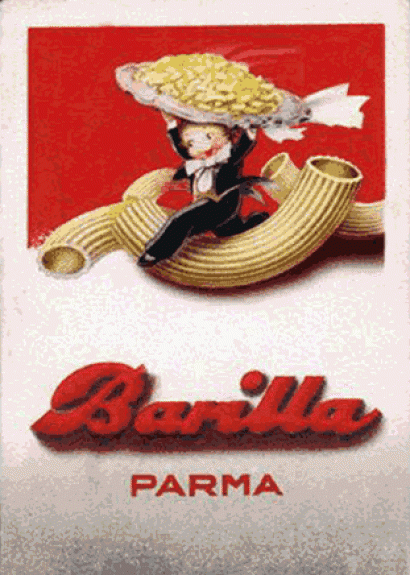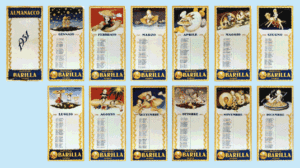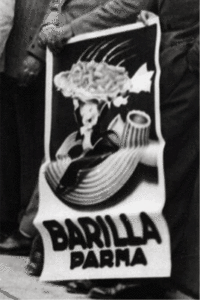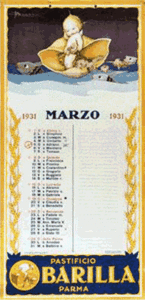1931 – Pasta and Futurism: the challenge of macaroni

At the dawn of the 1930s, advertising graphic art evolved both in taste and in design trait. In the 1931 symbol-image, a child is represented as a waiter riding giant macaroni pasta, and not anymore as the good natured shop assistant intent in kneading dough, but as a winking and mischievous Cupid, rosy and plump yet very agile and able to juggle to take off for a flight on that aerodynamic vehicle.
The subject is taken from the 1931 wall calendar printed by the Ricordi Graphic Industries of Milan and later on reprised in posters and postcards, that Adolfo Busi had designed for Barilla, in a daring language, ironically sensual and playful. Freshness of invention and witty uniqueness underlay the twelve small prints which correspond to the flowing of the months.
The author captures the secret sweetness of the Romantic and Symbolism style from the beautiful shapes of pasta, while infusing vitality to those formats that in the sales catalogs unfold with an effective aesthetic impact: with his fascinating animation, Busi calls on to big and little stars to shine on the firmament, on butterflies and “farfalloni” (large butterflies), wheels and surprises to lighten little impish genies.
Large Botticelli style pasta shells are perfect for an infant Venus, while an ingenious set up of pasta formats in the style of Depero, forms the body of the horse of a barely bearded Saint George. The calendar introduces a series of themes by mixing with festive irony now the memories of secessionist artistic tendencies and Déco cross references, now the synthesis of cylindrical shapes of Futurism in a harvest of anticipations of themes that later on appeared in the billboard poster art that followed.
 Adolfo Busi, 1931 Barilla Calendar. Milan, Industrie Grafiche Ricordi, 1930. ASB, Rla 16. |
 BUSI Adolfo, A waiter riding macaroni pasta. |
 The month of March from the 1931 calendar: ASB, Rla 16. |